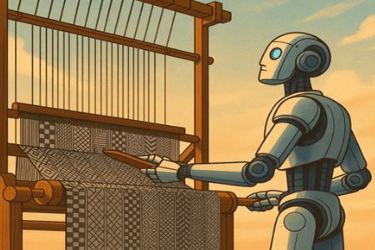The Future Of AI Is Looming

By Jim Lauria

When people talk about artificial intelligence, they tend to sort into four camps — what Reid Hoffman and Greg Beato describe in their book Superagency as doomers, gloomers, bloomers, and zoomers. The doomers fear the robot apocalypse. The gloomers worry AI will automate away all the meaningful jobs. The bloomers are optimistic about AI innovation but want to take a measured approach with guardrails as the technology develops. And the zoomers? They’re already deep into it and want minimal regulation to accelerate progress.
But I’d like to add a fifth mindset to the mix: the loomers.
Loomers see AI not as a force for destruction or salvation but as a tool — one that can transform creativity the same way the mechanical loom transformed garment production. In this analogy, AI isn’t a god or a demon. It’s a machine. And when put in the right hands, it can help us stitch together something truly human.
This isn’t about underwear branding though I’ll admit the phrase “fruit of the loom” inspired the title. It’s about the real fruit that comes from a new kind of loom: the fabric of ideas, art, and culture woven faster, more efficiently, and with surprising patterns thanks to AI.
A Brief History Of Looming Transformation
The Jacquard loom, introduced in 1804, was a marvel of its time. It used punch cards to control complex textile patterns, laying the foundation for modern computing. It didn’t eliminate tailors or fashion designers. It liberated them from repetitive tasks, enabled mass production, and allowed more time for vision and flair.
Textile workers feared automation. The Luddites famously smashed machines in protest, worried about job loss and dehumanization. And yet, the loom didn’t erase the artistry of fashion. It expanded what was possible.
Likewise, today’s generative AI — text generators, music models, image tools — is not here to replace writers, musicians, or illustrators. It’s here to do the grunt work. The threading. The templating. The “blank canvas” blocking. What we do with that freed-up creative energy? That’s the real story.
The Loomer’s Mindset
To loom is to prepare. To interlace. To weave something structured and new. The loomer’s mindset sees AI as:
- An assistant, not an author.
- A collaborator, not a competitor.
- A spark, not a firestorm.
For writers, designers, musicians, and storytellers, AI isn’t the replacement for imagination — it’s the warp to their weft.
The real fruit isn’t the content AI generates. It’s the conversations we can now have because of it. The insights we can now surface. The metaphors we can now mix (without a three-week editorial cycle).
Where others worry about what AI will take, loomers ask what it will make possible.
From Punch Cards To Prompt Craft
Just as loom operators learned the art of pattern selection and card programming, modern creators are learning prompt craft — the skill of guiding AI toward meaningful output. And just like the weavers of the past, today’s loomers must develop intuition, taste, and judgment. That’s not going away. It’s becoming more valuable.
Craftsmanship didn’t die with the loom. It evolved.
Creativity isn’t being replaced. It’s being rewoven.
“The Future Is Looming” Is Not A Threat — It’s A Thread
Yes, the phrase may carry a bit of ominous weight. “The future is looming” sounds like something out of a sci-fi cautionary tale. But let’s flip the perspective.
The future is looming because we’re actively weaving it. Every decision we make — about how to use AI ethically, creatively, and inclusively adds another thread to the tapestry.
The doomers and gloomers may see dark clouds on the horizon. The bloomers and zoomers are already building. But the loomers? We’re right at the interface, eye on the shuttle, hands on the thread.
Final Stitch
Reid Hoffman and Greg Beato’s Superagency encourages us to take agency over our technological future. Being a loomer is exactly that. It’s choosing to work with the machine, not against it. To guide the pattern, not surrender to randomness. To focus on what only humans can do: inject meaning, story, style, irony, humor — everything that makes a creation truly ours.
The loom didn’t spell the end of fabric design. It was the beginning of fashion.
AI isn’t the end of creativity. It’s the start of a richer weave.
And that’s the future I see looming…with possibility.
